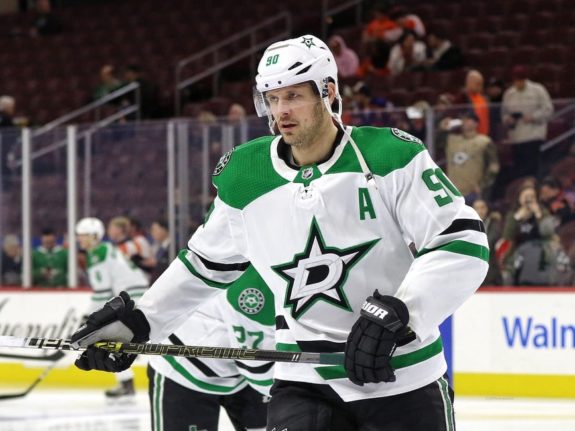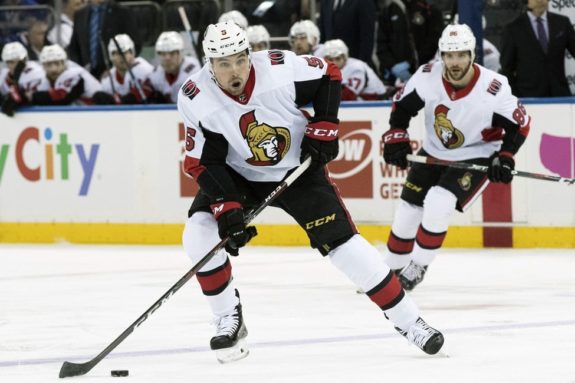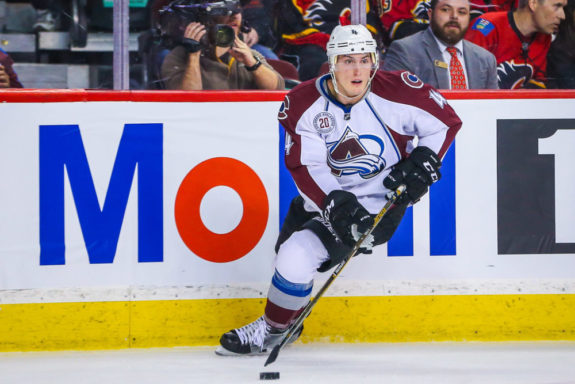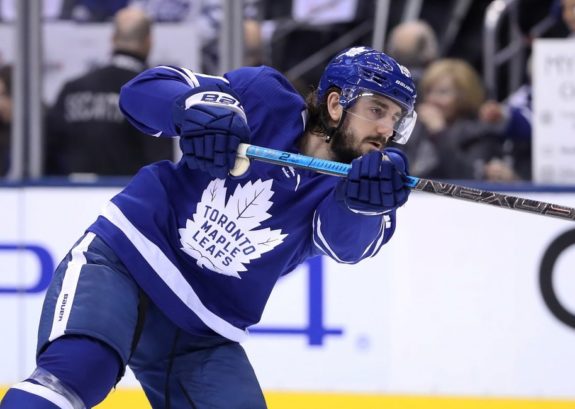The Toronto Maple Leafs are undoubtedly a Stanley Cup contender. Loaded up front, re-tooled on the back and with a rock in goal, this roster can certainly make a run. While three consecutive first-round exits presents a hump for the young team, there’s a lot to like about this group entering the 2019-20 season.
That said, even the best of teams have question marks each season. The NHL is chock-full of parity and showing up for 60 minutes 82 times a season is a necessity to win consistently in this league. With that in mind, let’s take a look at five questions that the Maple Leafs face entering the 2019-20 campaign.
What is Jason Spezza’s Role?
It didn’t take the cash-strapped Maple Leafs much time to ink veteran Jason Spezza to a league-minimum, one-year deal on the opening day of unrestricted free agency. As a result, it seemed there was an immediate fit between player and team, one that would assure him a roster spot — likely the fourth-line center role — entering the season.

It turns out we might need to loosen our grip on the thought that Spezza is a full-time lock on this roster. According to head coach Mike Babcock, there’s certainly a role on the team for the veteran; however, it’s still very much a “feeling it out” process for both parties.
At the end of the day, it would be shocking to see Spezza left off the Maple Leafs’ opening-night roster when they take on one of his former clubs, the Ottawa Senators, on Oct. 2. On top of the experience and leadership he brings to the table, Spezza tied New Jersey Devils center Travis Zajac for the best face-off mark in the league last season at 58.2% (minimum 800 face-offs). Winning draws is nothing new to him as he owns a 53.8% career face-off winning percentage, a number he’s eclipsed in six of the last seven seasons.
Spezza is also expected to contribute on the Maple Leafs’ second power play unit. Despite recording just 53 points over the last two seasons with the Dallas Stars, 23 of those points (or 43%) came on the man advantage. While goal-scoring and speed have never been the marquee assets of his game, his vision and ability to see the ice have been.
A fourth-line center and crucial face-off man — along with second-unit power play work — will be the role for Spezza. However, the feel-out process continues between a veteran player looking for one last shot at glory and a head coach that demands the most out of his role players.
What Should Frederik Andersen’s Workload Look Like?
According to many, Frederik Andersen has been the team’s MVP since arriving on the scene prior to the 2016-17 season. Andersen has been victimized by a poor blue line in his Maple Leafs tenure as the team has finished in the bottom 10 in shots against per game in each season he’s been there, and the bottom four in two of those three.

Since his arrival in Toronto, Andersen leads the league in starts (192), shots against (6,221), saves (5708) and goals against (513). He’s been the NHL’s busiest goaltender over the last three seasons and he will interestingly turn 30 when the season opens on Oct. 2.
As a result, now is the time to start reducing Andersen’s workload, and the goaltender himself is on board. While the plan could change depending on factors such as the standings, Andersen is likely in for somewhere around 55-60 starts this season, rather than the 66 starts he made in each of the first two seasons with the Maple Leafs. That number fell to 60 last season only due to a groin injury suffered just before Christmas.
The Maple Leafs need to keep their MVP healthy and rested. As a result, likely backup Michael Hutchinson is in for a workload as high as 25 starts, barring Andersen’s health. The debate will surely continue as the season moves along, but there’s little doubt that Andersen’s 66-start days are behind him.
Can Cody Ceci Handle Top-Pair Duty?
Along with Tyson Barrie, Cody Ceci is new to the Maple Leafs’ top-four on the blue line. Acquired in an offseason deal from the Senators, Ceci will be playing the most important season of his hockey career in 2019-20 as he is set for unrestricted free agency at season’s end. He is also set for top-pair duty alongside Morgan Rielly.

With the injury to Travis Dermott, which will keep him from the beginning of the season, and a lack of clarity regarding the Maple Leafs’ bottom defense pairing, it’s likely that Babcock will lean heavily on his top-four early on. That means plenty of minutes for Ceci against the opposition’s best, something that presents him an opportunity for a career-best season at both ends of the ice.
Whether he can take advantage of said opportunity remains to be seen. Ceci fell out of favor with his hometown Senators after six seasons with the club, the last three of which were laced with ugly plus/minus ratings and poor advanced metrics on some bad Ottawa teams. Playing on a much better Maple Leafs team could help, especially in defensive zone exits, something the Senators were atrocious at a season ago. When you’re playing the majority of the game in your own end, unfavorable ratings and metrics are a fact of life.
Along with Babcock and the front office, Leafs nation will undoubtedly have their collective microscopes on Ceci this season. As the now-departed Jake Gardiner found out last season, fans are tough on their defensemen. Whether Ceci can handle a top-pairing role is to be determined — and I think he can — but it could get ugly if he can’t.
Is the Defense Actually Improved?
My colleague Chris Faria wrote about this subject at length earlier in the offseason, so give his piece a good read for an in-depth comparison of last season’s group versus the new-look group this time around. It’s a fascinating discussion and an important one if the Maple Leafs plan to make a serious run at Lord Stanley’s Cup.

The Maple Leafs’ much-maligned right-side of their defensive core has been filled. In are Ceci and Tyson Barrie, out are Ron Hainsey and Nikita Zaitsev — both of whom will suit up for the rival Senators this season. Babcock now has his desired lefty-righty pairings in his top four, and will likely have the same situation take place on the bottom pair coming out of camp.
Still, with Ceci struggling as his Senators’ tenure wore down and Barrie very much an offense-first blueliner, it stands to wonder if the Maple Leafs’ defense is actually improved or if it just has new members aboard. Remember, the reliable Dermott is likely out for the first 12-14 games of the season, and while they added significant depth in the offseason, there isn’t a ton of experience or a track record of reliability in that depth.
It’s an admirable top four with a calculated blend of offense and defense in both pairs. However, whether or not this group is better than what we have seen in recent seasons is still very much in question.
Can the Bottom-Six Produce?
There’s absolutely no question the Maple Leafs sport one of the very best top-six forward groups in the game. John Tavares, Auston Matthews and Mitch Marner are already bonafide superstars, while William Nylander and Zach Hyman replacement, Kasperi Kapanen, have all the upside in the world. However, with Hyman also set to miss roughly the first month of the season and the need to move Kapanen up the lineup, the Maple Leafs are losing skill and production in their bottom six. Can the season-opening bottom six still get it done on offense?

First, it would make sense to figure out who will form the bottom-six forward group. Newcomer Alexander Kerfoot is a lock to start the season as the third-line center, and it’s overwhelmingly likely that the previously discussed Spezza will fill fourth-line center duties. Russian winger Ilya Mikheyev — signed to a one-year deal this offseason — is a big favorite to grab a left-wing spot, while Trevor Moore and Nic Petan are also likely to fill winger spots in the group. That would seemingly leave a fourth-line, right-wing spot for at least half a dozen players to battle for in training camp.
With Spezza’s offensive game declining by the season, Moore and Petan combining for just 9 points with the team in 30 games last season, Mikheyev a complete unknown and a wild card set to fill out the group, it would appear that Kerfoot stands alone as the only reliable offensive producer in the bottom six after two 40-point seasons with the Colorado Avalanche to begin his career. All of a sudden, the Maple Leafs may not be so flush with offensive production up and down their lineup — something that’s been the team’s calling card in each of the last three seasons.
The bottom six will simultaneously be asked to help keep the puck out of their own net, but there’s a need for at least one or two members of this group outside of Kerfoot to elevate their offensive game and provide the elite top six with some goal support, at least to start the season.